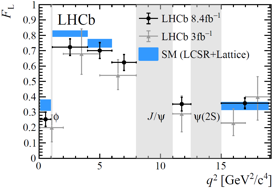The Bs→φμ+μ– branching fraction measured below the Standard Model prediction.
This week at the Flavor Physics and CP Violation (FPCP) conference in Shanghai, China, the LHCb Collaboration presented a measurement of the Bs→φμ+μ– branching fraction and the angular analysis of its decay products. A previous branching fraction measurement using the Run 1 data set obtained a tension with the Standard Model (SM) prediction at the level of three standard deviations (σ). The analysis reported this week used the full Run 1 and Run 2 dataset, about four times more decays of Bs mesons, and confirmed the tension, which is now at the level of 3.6σ, depending on the details of the theory prediction.
As reported often at this web page, recent studies of b→sll (l=e, μ, or τ leptons) rare beauty particle decays exhibit tensions between experimental results and the SM predictions of branching fractions, angular distributions and lepton universality. None of these results is significant enough to constitute observation of new physics on their own. However, according to theorists who study possible extensions of the SM, these tensions combined suggest an interesting and coherent pattern.

The image above shows the measured values of branching ratio as a function of the squared invariant mass of μ+μ– pair, q2, compared with the SM predictions. Calculating these predictions is particularly challenging. Theorist have to account for the hadronic physics involved in turning a Bs meson into a φ meson following the b→s quark transition, so-called form factors, in addition to hard-to-model interference effects from other hadronic processes. The SM predictions are based on form factor calculations using Light Cone Sum Rules (LCSRs) at low q2 and Lattice QCD (LQCD) at high q2. In the q2 region between 1.1 and 6.0 GeV2, the measured branching fraction lies 3.6σ below a SM prediction which used both LCSR and LQCD calculations (or 1.8σ with LCSR calculations alone). This deficit in muons follows the same pattern as observed in lepton flavour universality tests, which is very interesting. However, the difficulty of parameterising hadronic effects in the branching fraction prediction calls for caution, as, unlike in lepton flavour universality tests, the discrepancy seen here could be due to inaccuracies in the SM predictions.
Angular analyses of the Bs→φμ+μ– decays provide complementary information to the branching fraction measurement and allows to better probe the structure of potential new physics. Overall, the results are in good agreement with the SM predictions, with the largest deviation in a single observable being measured in FL, as shown in the image on the left along with the corresponding SM predictions.
To assess the overall agreement of all the angular observables with the SM, a global fit to the observables was performed using the FLAVIO package. Global fits allow to determine constants (referred to as effective couplings) related to the forces experienced by the particles during the decay. Of particular interest is the effective coupling Re(C9) [for experts: the real value of the vector coupling]. The favoured value of Re(C9) lies below the SM prediction and is preferred over the SM by 1.9 σ, which is consistent with the behaviour seen in B0→K*μ+μ– and B0→K*+μ+μ– angular analyses.
Read more in the conference presentation, in the branching fraction publication and in the forthcoming angular analysis paper.

